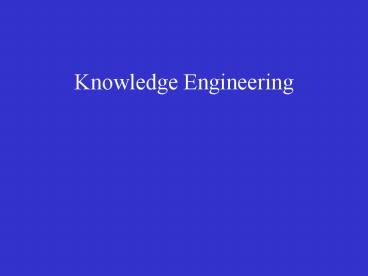Knowledge Engineering - PowerPoint PPT Presentation
1 / 17
Title:
Knowledge Engineering
Description:
(Frame) AKO. Value. Human (Slot) Sex. Default. Value. Male (Slot) Age ... (Frame) AKO. Value. Man (Slot) Height. If Needed (Weight/Age) (Slot) Age. Default. 35 ... – PowerPoint PPT presentation
Number of Views:173
Avg rating:3.0/5.0
Title: Knowledge Engineering
1
Knowledge Engineering
2
- Sources of Knowledge
- Books - Journals - Manuals - Reports -
Films - Databases - Pictures - Audio and Video
Tapes - Flow Diagram - Observed Behavior -
Knowledge stored in experts mind
3
- Knowledge Acquisition Issues
- The basic concepts and terms - The inputs to
the problem, which of them are difficult? - The
interrelationships between data items - The
degree of certainty of the data (inputs,
outputs) - Typical solutions to the problem,
what are their characteristics? - Sources of
knowledge - Methods of knowledge acquisition -
The underlying assumptions, and constraints -
The conflicts, and exception rules
4
- Methods of Knowledge Acquisition
- Interview - Observation of Experts -
Questionnaires - Analysis of Documented
Knowledge - Computer-Aided Elicitation
5
- Methods of Knowledge Representation
- Propositional Logic - Rules - Frames -
Semantic Networks
6
- Propositional Logic
- Knowledge is presented in propositions that make
logical inference possible. - Example
- Proposition 1 - If we increase marketing budget,
sales - will
increase. - Proposition 2 - We have increased
marketing budget. - Inference - Sales will increase.
7
- Production Rules
- Knowledge is presented as rules, called
productions, in the following form - IF (condition, or premise)
- THEN (result, action, or consequent)
- Example
- IF a persons right hand is larger than his
left hand - THEN his job type is/has been manual
labor.
8
- Frames
- A frame is a description of an object that
contains slots for all the information associated
with the object. Frames are arranged in
hierarchies.
9
- Example
- .
(Frame) Human
(Slot) Legs
(Slot) Weight
Value
2
150
Default
(Frame) Man
(Slot) Sex
Value
Male
(Frame) AKO
Value
Human
(Slot) Age
Default
35
10
- More on Example
- .
(Frame) Man
(Slot) Sex
Value
Male
(Frame) AKO
Value
Human
(Slot) Age
Default
35
(Frame) Bob
(Slot) Height
(Frame) AKO
If Needed
(Weight/Age)
Value
Man
11
- Semantic Networks
A semantic network is a collection of objects
called nodes. The nodes are connected together
by arcs or links. Nodes describe facts like
physical objects, concepts or situations, where
arcs define the relevant relationships among
objects.
12
- Fragments of a Computer
- Semantic Network
MICROCOMPUTER is-a COMPUTER
DISKDRIVE is-part
MICROCOMPUTER IBM PC
is-a MICROCOMPUTER IBM PC
color BEIGE IBM
PC is-attached HP
LASER JET IBM PC owner
JOHN HP LASER JET is-a
PRINTER JOHN
is-a PERSON
13
- Semantic Network
-
COMPUTER -
is-a is-part - PERSON MICROCOMPUTER
DISK - is-a
is-a DRIVE -
- JOHN IBM PC
HP LASER JET - owner
is-attached -
color
is-a -
-
BEIGE PRINTER
14
- Advantages of Different Representations
- Production Rules Simple syntax, easy to
understand, easy to - add or
modify - Semantic Networks Easy to follow hierarchy,
easy to trace -
association, flexible - Frames Expressive power,
easy to set up slots for - new
properties, easy to include default - information
and detect missing values - Formal Logic Facts asserted
independently of use, - guarantee
that all and only valid -
consequences are asserted
15
- Disadvantages of Different Representations
- Production Rules Hard to follow
hierarchies, inefficient for - large
systems, not all knowledge can be - represented
as rules - Semantic Networks Meaning attached to nodes
might be - ambiguous,
exception handling is hard - Frames Difficult to
program, difficult for inference, - lack of
inexpensive software - Formal Logic Inefficient with
large data sets, very slow - with large
knowledge base
16
- Inference Control Strategies
Backward Chaining - This method, also called
goal directed reasoning, entails having a goal
or a hypothesis as a starting point and then
working backward along some paths to see if
the conclusion is correct.
17
- Inference Control Strategies
Forward Chaining - Is used for problem solving
when data or basic ideas are a starting point.
Under this method, the system does not start
with any particular goals defined for it. It
works from facts to conclusions. It reasons
forward starting with data supplied by the user
and applies all rules whose if parts are
satisfied. Forward chaining often is described
as data-driven or event-driven reasoning.































